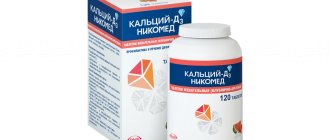Instructions for use of Ultra-D
Vitamin D3 (or cholecalciferol) is a biologically active substance, a vitamin belonging to the fat-soluble group. It has been proven that vitamin D regulates calcium-phosphorus metabolism and is necessary to enhance the absorption of calcium from the stomach and delivery to various tissues of the body, as well as the reabsorption of phosphorus in the renal tubules.
A lack of vitamin D3 in the body can be caused by insufficient exposure to the sun or a lack of vitamin D3 in food. With a deficiency of vitamin D3, the content of calcium and phosphate in the blood decreases.
Application area
Ultra-D Vitamin D3 25 mcg (1000 IU) is recommended for use: as a biologically active food supplement - an additional source of vitamin D.
Compound
1 tablet contains: Cholecalciferol (vitamin D3) - 25 mcg (1000 IU).
Auxiliary ingredients: xylitol sweetener (E967), sorbitol sweetener (E420), hydroxypropylcellulose thickener (E463), anti-caking agent magnesium fatty acid salts, antioxidant alpha-tocopherol (E307), palm oil, modified starch carrier (E1450), sucrose, antioxidant ascorbate sodium (E301), anti-caking agent amorphous silicon dioxide (E551), raspberry flavor, peach flavor.
Ultra-D Vitamin D3 25 mcg (1000 IU) is available in the form of chewable tablets weighing 425 mg.
Vitamin D3, or cholecalciferol, is a biologically active substance, a fat-soluble vitamin. It enters the human body with food, but its content in foods is low, and absorption is possible only in a healthy intestine. Most of the vitamin must be synthesized in the skin under the influence of ultraviolet radiation, but subject to sufficient time in the sun and sufficient intensity of UV irradiation. According to epidemiological studies (1), more than 80% of the adult population in Russia has a deficiency or deficiency of vitamin D, and such deficiency is observed in both summer and winter. Only 3.5% of women in Russia have normal vitamin D levels (2).
The biological role of vitamin D is explained by the presence of specific receptors in more than 40 organs and tissues and the control of more than 200 genes (3).
Classic effects are associated with the regulation of calcium-phosphorus metabolism: vitamin D increases the absorption of calcium and phosphorus in the intestine, increases their reabsorption by the kidneys, increases mineralization and elasticity of bone tissue, normalizes neuromuscular transmission, prevents myopathies due to disturbances in mineral metabolism (manifested by muscle weakness , difficulty walking, maintaining balance and a tendency to fall).
Adequate levels of vitamin D in children prevent the development of rickets, and in adults, osteomalacia (decreased bone strength) (3).
Non-classical (extraosseous effects):
Reproductive functions: Vitamin D can have a positive effect on the production of sex hormones (estradiol and progesterone). Vitamin D deficiency occurs in 67-85% of women with polycystic ovary syndrome (2). At the same time, restoration of the recommended concentrations of vitamin D in the blood of these women helps to correct metabolic disorders, improve the quality of the endometrium, and restore the menstrual cycle (8). In IVF programs, pregnancy occurs 1.5 times more often in women with sufficient levels of vitamin D (9).
The likelihood of having a child after ART/IVF is significantly higher in women without vitamin D deficiency (10). Low vitamin D levels are associated with an increased risk of developing endometriosis (2). During menopause, the need for vitamin D increases due to the increased risk of osteoporosis (11).
Pregnancy: During this period, vitamin D is especially important for both the mother and the unborn child. Research shows that low vitamin D levels are associated with an increased risk of gestational diabetes, preterm birth (2), preeclampsia, and cesarean section (9). Hypovitaminosis D in the mother leads to rickets in children, including congenital, increased risk of intrauterine infection and impaired immune regulation (12). Children born to mothers with normal vitamin D levels are less likely to suffer from viral respiratory infections and bronchiolitis (3).
Lactation: Breastfeeding is a time of increased vitamin D demand for the mother (11).
Male fertility: Vitamin D deficiency in men can lead to the development of secondary hypogonadism (lack of sex hormones), decreased testosterone production, abnormalities in spermogram parameters (decrease in the total number of sperm, the number of sperm with normal morphology and a decrease in their motility and linear speed), as well as - to an increased risk of developing type II diabetes mellitus, which is a fact of the development of male infertility (13,14).
Nervous system: by participating in the production of neurotransmitters (substances that transmit impulses between neurons), vitamin D has a positive effect on cognitive functions, psycho-emotional sphere and performance, improves mood and helps fight stress (3, 4).
Immune system: immunomodulatory effect is associated with the activation of all parts of the immune system. Vitamin D stimulates the activity of immune system cells in the bone marrow and has anti-inflammatory properties (5).
Metabolism: normal levels of vitamin D help normalize fat metabolism, have a positive effect on the course of metabolic syndrome, and reduce the level of total cholesterol, triglycerides and low-density lipids. Normalization of energy production in cells leads to increased vitality (6).
Endocrine system: Vitamin D deficiency plays a role in the formation of insulin resistance and glucose tolerance. According to research, against the background of vitamin D deficiency, the production of insulin by pancreatic cells decreases (3), and the functioning of the parathyroid gland and adrenal glands is disrupted (7).
Recommendations for use: adults, 1/2 tablet 1 time per day with meals.
The recommended daily dose (1/2 tablet) contains:
| Component | Sod. in 1/2 table. | % of rec. ur. days consumption* | % of rec. day level consumption for women** | ||
| childbearing age*, 1st half of pregnancy | 2nd half of pregnancy | nursing | |||
| Vitamin D3 | 12.5 mcg (500 IU) | 250*** | 125-250*** | 100 | 100 |
* — TR CU 022/2011 “Food products regarding their labeling”;
** - MP 2.3.1.2432-08. Norms of physiological needs for energy and nutrients for various groups of the population of the Russian Federation. M., 2008;
*** Does not exceed the upper permissible level of consumption, Unified sanitary-epidemiological and hygienic requirements for goods subject to sanitary-epidemiological supervision (control).
Duration of treatment: 2 weeks. It is recommended to consult a doctor before use.
Contraindications: Individual intolerance to the components.
Important additional information:
The determination of the daily dose and duration of vitamin D intake can be made individually by the doctor, depending on the results of laboratory tests and medical history, and may differ from that recommended in this leaflet. Do not exceed the dose recommended by your doctor.
Thanks to solubilization (interaction with saliva components), absorption of the vitamin from chewable tablets Ultra-D Vitamin D3 25 mcg (1000 IU) begins in the oral cavity.
The mucous membrane of the oral cavity is abundantly supplied with blood, so vitamin D quickly enters the bloodstream. After ingestion, vitamin D absorption continues in the small intestine through the formation of micelles (multilayered colloidal particles) (16, 20). The dual absorption mechanism of cholecalciferol from the chewable tablet ensures a high absorption rate and the achievement of adequate serum vitamin D levels (20).
The occurrence of side effects of vitamin D directly depends on the dose consumed; side effects occur if recommended doses are significantly exceeded. Symptoms of hypervitaminosis: increased calcium levels in the blood, nausea, vomiting, headache, muscle pain, palpitations, decreased appetite, thirst, weakness.
Contains sweetener. If used excessively, it may have a laxative effect.
Nutritional value of 1 tablet: sugar alcohols - 0.4 g, energy value - 0.9 kcal (4.9 kJ).
FAQ:
How to assess vitamin D levels?
For an objective assessment, it is necessary to conduct a blood test for 25(OH)D content.
Table 1. Interpretation of blood test data (11).
| Condition classification | Vitamin D level in blood plasma |
| Severe vitamin D deficiency | < 10 ng/ml (< 25 nmol/l) |
| Vitamin D deficiency | < 20 ng/ml (50 nmol/l) |
| Vitamin D deficiency | 20-30 ng/ml (50-75 nmol/l) |
| Adequate Vitamin D Levels | > 30 ng/ml (75 nmol/l) |
| Recommended Vitamin D Levels | 40-60 ng/ml (100-150 nmol/l) |
Do I need to take a blood test for vitamin D levels?
Yes, if this test was recommended by a doctor; if you are at risk for developing vitamin D deficiency (pregnant and lactating women, elderly (over 60 years old), people with limited sun exposure, dark-skinned people, obese people, gastrointestinal absorption disorders (Crohn's disease, celiac disease, nonspecific ulcerative colitis, bariatric surgery, cystic fibrosis), taking long-term courses of drug therapy (glucocorticoids, antiretroviral drugs, antifungals, antiepileptic drugs), with chronic renal and liver failure) (11).
Is it possible to determine the need to take vitamin D without tests?
Yes, it's possible. According to the Russian Society of Endocrinologists (11), the majority of the Russian population has insufficiency or deficiency of vitamin D. This is explained by the low content of the vitamin in food; insufficient intensity of ultraviolet radiation in the population living above the 35th parallel (all of Russia) and insufficient time spent in the sun. It is recommended to correct states of deficiency and insufficiency with additional vitamin D intake.
Is it possible to take vitamin D without testing the level of vitamin D in the blood?
Yes, you can. In accordance with the recommendations of the Russian Society of Endocrinologists (11), if it is not possible to control the level of 25(OH)D, for long-term use (more than 6 months) a dose of no higher than 4000 IU per day is recommended for adults - for persons without risk factors; and no more than 10,000 IU per day - for individuals at risk of developing vitamin D deficiency.
If the doctor recommended taking a higher dose of vitamin D, was he wrong?
In accordance with modern recommendations of the Russian Society of Endocrinologists (11), to maintain optimal plasma concentrations of vitamin D, for example, prophylactic intake of 1500-2000 IU per day is required. If absorption or metabolism of vitamin D is impaired (for example, obesity), the daily dose should be increased by 2-3 times. If a vitamin deficiency or insufficiency is diagnosed, the doctor calculates the dose of the vitamin you need depending on the severity of the disorder, and this dose may significantly exceed the dose recommended to prevent deficiency.
Do I need to take vitamin D during the planning stage and during pregnancy?
During these periods of a woman’s life, vitamin D is especially necessary for both the mother and the unborn child. At the stage of preparation for pregnancy, it is recommended to take proactive or deficiency-correcting doses (if a vitamin deficiency is detected). Hypovitaminosis D in these situations is subject to mandatory correction (17,18). When pregnancy occurs, the dosage of vitamin D intake is determined by the doctor.
Can I take vitamin D if I have kidney disease?
If your kidney function is impaired, you should consult your doctor about the use of vitamin D. According to international recommendations (19), in the presence of kidney stones and nephrocalcinosis, vitamin D can be safely prescribed, but without concomitant calcium supplementation.
Best before date:
3 years.
Do not use after the expiration date stated on the packaging.
Storage conditions:
Store in the original packaging in a dry place, out of reach of children, at a temperature not exceeding 25°C.
Release form:
Chewable tablets, 25 mcg (1000 IU). 30, 60, 90, 120, 180, 240, 360 or 720 chewable tablets in a plastic bottle with a plastic cap.
There are 2 types of product packaging available:
- A label is attached to the bottle.
- A label is attached to the bottle. 1 bottle is packaged in a cardboard box with an insert.
Manufacturer:
Pharma OY, Kalliotie 2, FI-04360, Tuusula, Finland for Orion Corporation, Orionintie 1, 02200, Espoo (Orion Corporation, Orionintie 1, 02200, Espoo) ), Finland.
Importer and organization authorized to accept claims from consumers in Russia: Orion Pharma LLC 119034, Russia, Moscow, Sechenovsky per., 6, building 3
tel
tel/fax
Places of sale are determined by the national legislation of the member states of the Eurasian Economic Union.
State registration certificate number and date: RU.77.99.88.003.E.005674.12.18 dated 12/19/2018
E.A.C.
Bibliography
1. Lesnyak O. M., Nikitinskaya O. A. et al. “Prevention, diagnosis and treatment of vitamin D and calcium deficiency in the adult population of Russia and patients with osteoporosis (based on prepared clinical recommendations).” Scientific and practical rheumatology. 2015;53(4):403-408. 2. I. E. Zazerskaya “Vitamin D and women’s reproductive health”, Eco Vector St. Petersburg 2022. 3. Michael F. Holick, Vitamin D Deficiency The new England journal of medicine July 19, 2007. 4. Mathias Schlogl, Michael F Holick Vitamin D and neurocognitive function Clinical Interventions in Aging 2014:9. 5. N. V. RYLOVA, S. V. MALTSEV, A. V. ZHOLINSKY The role of vitamin D in the regulation of the immune system 'PRACTICAL MEDICINE 5 (106) September 2022 6. Tina Jafari, et al Effects of vitamin D on serum lipid profile in patients with type 2 diabetes: A meta-analysis of randomized controlled trials./Clinical Nutrition. 35 (2016), 1259-1268. 7. Adriana S. Dusso Update on the Biological Role of the Vitamin D Endocrine System Current Vascular Pharmacology Volume 12, Issue 2, 2014. 8. Lerchbaum E, et al Vitamin D and fertility: a systematic review. Eur J Endocrinol. May 2012; 166(5):765-78. 9. C. L. Wagner. et al; Journal of Steroid Biochemistry & Molecular Biology 148 (2015) 256–260. 10. Zhao J, et al “Whether vitamin D was associated with clinical outcome after IVF/ICSI: a systematic review and meta-analysis.” Reprod Biol Endocrinol. 2022 Feb 9;16(1):13. 11. RUSSIAN ASSOCIATION OF ENDOCRINOLOGISTS. CLINICAL GUIDELINES. VITAMIN D DEFICIENCY IN ADULTS: DIAGNOSIS, TREATMENT AND PREVENTION. Ministry of Health of the Russian Federation 2015. 12. L. I. MALTSEVA, et al. Vitamin D provision and correction of its deficiency during pregnancy. PRACTICAL MEDICINE 5 (106) September 2017 13. Cristina de Angelis, et al The role of vitamin D in male fertility: A focus on the testis. Rev Endocr Metab Disord (2017) 18:285–305. 14. Gromova O. A., et al. On the roles of vitamin D in the prevention and treatment of male infertility. QUALITATIVE CLINICAL PRACTICE No. 3 2022. 15. Torshin I. Yu., Gromova O. A. Pharmacokinetic analysis of vitamin D preparations for oral administration. Pharmacokinetics and pharmacodynamics, No. 3 2022. 16. Vaibhav Kumar Maurya Factors influencing the absorption of vitamin D in GIT: an overview. J Food Sci Technol (November 2017) 54(12):3753–3765. 17. Pre-gravid preparation. Clinical protocol. Approved by Protocol No. 4P-16 of the Presidium of the Board of the Interdisciplinary Association of Reproductive Medicine Specialists (MARS) dated June 28, 2016. 18. Roth DE Vitamin D supplementation during pregnancy: safety considerations in the design and interpretation of clinical trials. J Perinatol. July 2011; 31(7):449-59. 19. GUIDELINES FOR THE PRESCRIPTION OF VITAMIN D IN ADULTS. NHS.2013 (https://slidex.tips/download/guidelines-for-the-prescribing-of-vitamin-d-in-adults). 20. Shikh E. V. et al. Analysis of the experience of using various dosing regimens of cholecalciferol to achieve adequate levels in patients with reproductive disorders, “Obstetrics and Gynecology”, No. 1 2022.
What it is
Vitamin D is the collective name for a group of calciferols - fat-soluble organic compounds. For humans, the most significant active varieties are D2 - ergocalciferol, which enters the body only with food, and D3 - cholecalciferol, supplied both with food or supplements, and synthesized by skin cells in the light. Some researchers even find support for the hypothesis that vitamin D can be considered an indicator of impaired health and a potential universal remedy for its restoration.
Vitamin D is necessary for the complete absorption and assimilation of calcium, without which mineralization and bone growth are impossible. D also regulates the metabolic metabolism of phosphorus compounds and is involved in some other biochemical reactions, the research of which is ongoing.
“Vitamin D for the body is like gasoline for a motor,” explains endocrinologist Olga Shamrina. - In fact, it is a prohormone, it gives effects similar to hormonal ones. For example, it regulates the formation of the sex hormones testosterone and estrogen from cholesterol. Participates in the synthesis of thyroid hormones - the main anti-stress center of the body, responsible for reducing the perception of stress. Vitamin D corrects insulin levels in the blood, speeds up metabolism, promotes the absorption of beneficial elements from food and at the same time lose weight. It regulates all human life at the cellular level, including acting as an immunomodulator.”



